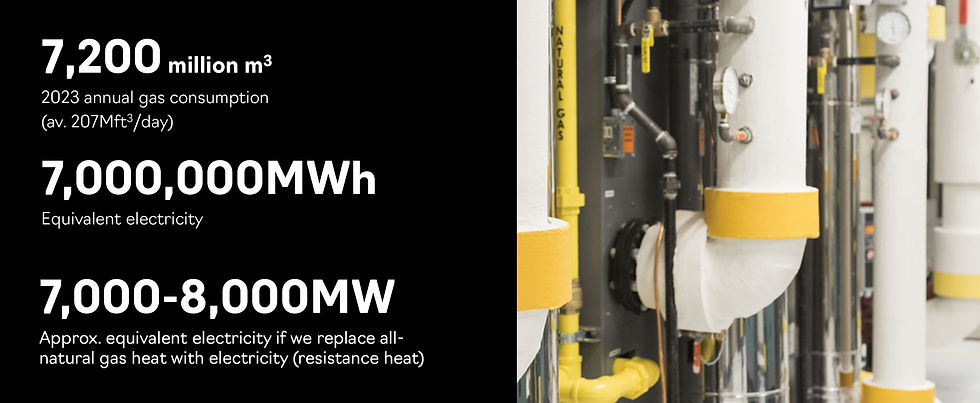Did you know that electrification could be the solution to reducing our reliance on fossil fuels? Imagine a world where electric vehicles whisk us away and buildings are heated without burning a drop of oil or gas. This exciting transformation is all about utilizing electricity to reshape our transportation and heating systems.

However, there's a catch. The electrification process is happening without adequate planning for the strain it may put on our electrical infrastructure for generating and distributing electricity. In part two of our blog, we'll present factual evidence to support our subjective arguments made earlier and raise the question: is it a myth that we can electrify our way out of reliance on fossil fuels?
Electricity Facts
In Manitoba, we have traditionally viewed our electrical system as an abundant and virtually
limitless resource that is greener than some of our neighbours to the west, which rely on fossil fuels for power generation. This perception is largely due to the substantial investments made by our utility in hydroelectric power generation over the past century.

However, this perception is changing as our peak electrical demand in winter hovers around 4,460 - 4,925 MW, with an additional 1,600 MW dedicated to exports. It's clear that our electrical capacity is not infinite. While it is true that some long-term export contracts will expire in 2027/8, the amount of power capacity returned is not sufficient to meet our electrification needs. Therefore, there is a need for us to reevaluate our approach to electricity usage.
Natural Gas Facts
Our reliance on natural gas adds another layer of complexity to Manitoba's energy landscape. Surprisingly, the equivalent power we consume from natural gas is higher than the equivalent power we consume from hydro-electrically generated electricity. This raises concerns about how eco-friendly our overall energy consumption really is.

In 2023, we consumed around 7,200 million cubic meters of natural gas, which produced approximately 7,000 GWh of electricity. While geothermal systems are viable alternatives, making the shift to electricity would require a significant increase in peak power, potentially reaching up to 7,000 - 8,000 MW of equivalent capacity. This additional capacity would be on top of our current peak demand and export contracts.
Electric Vehicles
The emergence of EVs adds another dimension to the electrical infrastructure challenge. By 2035, the Canadian government has mandated that 100% of vehicle sales are to be zero-emission vehicles. Although EV adoption has been slower in Manitoba compared to other parts of Canada and similar climates like Norway, legislation indicates there will be a substantial increase in electrical demand.

Given that approximately 44,000 vehicles are registered annually in our province and there are over 941,000 vehicles already on the road, the transition to electric vehicles (EVs) has the potential to increase demand by 600 to 2,000 MW. However, if we take into account the full electrical impact of electrifying the commercial vehicle inventory, this demand could rise significantly higher.
Myth-Busted
In its current condition, the assumption that our current electrical generation capacity can decarbonize our future is wrong. The barn door is open, and the horse has bolted. There is a significant shortfall between the current generating peak power and the forecasted peak power consumption after electrification.

When factoring in both passenger EVs and heating for buildings, a significant shortfall in electrical generating capacity emerges. Without significant investment, innovation and a change in habits, the myth of electrification as a solution for decarbonization is entirely busted.
The Usual Solutions Won’t Work
Renewable energy sources like solar and wind present promising avenues, but they are an intermittent source of power generation. Without viable and economical means of storing electricity or energy, these renewable resources are not the solution. The lack of generating capacity is also only part of the problem. Scaling up the distribution infrastructure to accommodate increased electrical demand is a formidable task, noting that much of downtown Winnipeg’s electrical infrastructure dates back to the 1950s.
Potential Solutions
While the path forward may seem daunting, avenues for the sustainable use of our electrical resources to help significantly reduce our reliance on fossil fuels exist. Retrofitting existing buildings for energy efficiency, exploring alternative heating methods, leveraging renewables strategically, implementing smart metering, and crucially investing in both generation and distribution infrastructure emerge as key strategies. This may mean that we continue to use fossil fuels for the foreseeable, but we use them in a way that is entirely more efficient. Old building stock must be upgraded, and the financial funds must be provided through smart carbon taxation, which creates a direct means to fund these initiatives.

Several real-world examples demonstrate that targeted interventions can make a significant impact on lowering carbon emissions. From straightforward energy-saving measures to ambitious mechanical plant replacements and envelope upgrades, these initiatives showcase tangible progress toward decarbonization without solely relying on full electrification.
Conclusion
The journey towards decarbonization through electricity is fraught with challenges, but these challenges are not insurmountable. Electrification alone is not the answer. A holistic approach is required, which includes investment in reshaping our electrical generation and distribution landscape for a sustainable future. The days of abundant, artificially cheap electricity are over. Without investment, smart carbon taxation and a sustainable increase in our utility rates, we will not have the electrical resources required, and we will be left behind.


Comments